Last year we noticed a very common invasive species showing up at the Prescott Garden: Japanese Knotweed. It is all over the Halifax Peninsula, and can be a very beautiful, full and tall plant that easily grows just about anywhere. You will probably recognize it, and once you know what it is, you’ll notice it all over the place.
We really don’t want to let this thing take over the garden. It spreads its roots far and wide and can show up in the least suspecting places. Truly, I’m not even sure how it got to the garden in the first place. But with some dedication, we can prevent it from spreading and keep it under control.
This is what Japanese Knotweed looks like when it is very young, somewhat mature, and very mature:

Young Japanese Knotweed, just emerging from the ground

Japanese Knotweed at a mid-growth stage
Keeping this beast under control will require regular maintenance all summer. Every time you come to the garden, please get into the habit of taking a few minutes to locate and dig up some Japanese Knotweed plants.
Things to know and do:
1. Japanese Knotweed has been spotted all along the eastern side of the garden, behind the compost, amidst the trees and rocks. Walk through this area and have a look for emerging shoots.
2. When you see a shoot, take a shovel, and dig as deeply as you can to get as much root as possible. Try as hard as you can not to break off the stem.
3. DO NOT put this plant in the compost. Throw it in the garbage, or take it home and put in the Municipal Green Bin. Or…
4. Eat it! Japanese Knotweed is edible and has similar properties to rhubarb so can be used in much the same way. Yum!
Thank you, everyone, for helping to keep this pesky thing under control.

